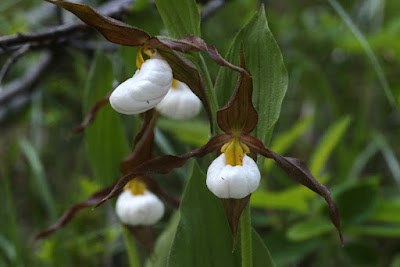We visited recently a site on Whidbey Island where we had seen the Western Coralroot, Corallorhiza mertensiana, many times before, but we did not find very many of them this year, though enough to photograph. These showed the usual rainbow of colors with pink, purple, white, tan and yellow stems and endless variation in the spotting of the flowers and coloring of the lip.
Corallorhiza mertensiana
Corallorhiza mertensiana fma. pallida
At the same site we found a few stems of the Ozette Coralroot, Corallorhiza maculata var. ozettensis, an unspotted form and a recent discovery. We had seen it at other sites on Whidbey Island but this was the first time we found it growing with the Western Coralroots. We'll be visiting another site in the near future to photograph it there, a site where it grows in abundance.







































































